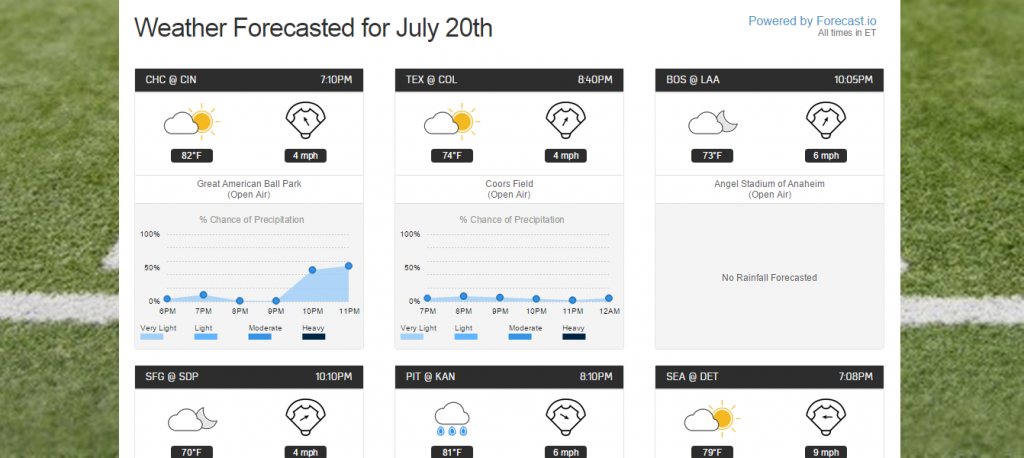Is Yahoo! Daily Fantasy the Third Wheel?
The two titans of daily fantasy sports (DFS), DraftKings and FanDuel, have new competition. Recently, Yahoo! has joined the daily fantasy goings on in addition to their traditional fantasy sports leagues. The market growth of DFS sites has taken off on a meteoric rise, and according to Forbes there was an 847 percent rise in participation from September 2013 to September 2014. As the newest option in a popular area, Yahoo!’s approach is slightly different than both DraftKings or FanDuel.
Right off the bat, the aesthetics of Yahoo! appears similar to FanDuel. From left to right, we have the Yahoo!, FanDuel and DrafKings interfaces (click to embiggen).
Beyond the layout, Yahoo! has seemingly drawn influence from both FanDuel and DraftKings for the gameplay itself. Just like in DK, Yahoo! allows users to draft up to 10 players rather than the nine of FD, the difference being two pitchers in the former and one in the latter. Despite the identical rosters to DK, Yahoo!’s player prices are much different than anything we’ve seen before.
Rather than use the $50,000 or $35,000 salary allotment of DraftKings and FanDuel respectively, Yahoo! has a $200 scaled budget. As a percentage, the prices aren’t terribly different, but I found myself having a surprisingly difficult time adjusting. Of course, the prices are different because the scoring is different as well.
With the same left to right as before, the following picture shows the scoring differences between the three sites.
Where both FanDuel and DraftKings have negative stats for batters — -0.25 points for any out on FD or -2 points for a caught stealing on DK — Yahoo! doesn’t have a way of punishing poor batting or base running performances. Pitching statistics are even more varied as wins are very heavily valued in Yahoo! at eight points compared to four points for DK and FD. Yahoo!’s only negative pitching category is giving up earned runs, same as FanDuel, to the tune of -1 point per earned run surrendered. For example, let’s say a pitcher costs 20 percent of your budget in any of the three site ($40 in Y!,$ 7,000 in FD and $10,000 in DK) . He records a win after going seven innings, gives up two runs on a pair of solo shots, plus two other hits, two walks and strikes out seven batters, his point totals for each site are:
Yahoo!: 30.6 points
FanDuel: 16 points
DraftKings: 23.35 points
Thanks to the numerous negative pitching stats in DratfKings (hits and walks in this example specifically), you get hands down the least bang for your buck with pitchers compared to FanDuel and Yahoo!. The latter in particular places a massive emphasis on wins at eight points. Such huge upside in pitches in Yahoo! with minimal downside — no negative points for any hitter outcomes and only being penalized on pitcher earned runs — makes stacking your Yahoo! lineup with the best pitchers in line for the win is hands down the best option. This isn’t a flaw, a strength or a weakness on Yahoo!’s behalf, but it is certainly something to exploit.
The biggest issue I have with Yahoo!’s current layout is the lack of weather information for each game. DraftKings at least displays weather info at the top of the screen when you enter a contest.
FanDuel leads the way with a full weather forecast for each game, including chance of rain by percentage and if the game will be played in an open stadium, retractable roof or dome.
I’d always recommend cross checking the weather for the games as in any DFS format it hurts to lose a batter to a rain out and losing a starting pitcher is like throwing money away. Adding in weather seems like something fairly easy, as Yahoo! already has an entire page dedicated to weather around the world.
Beyond the weather related issues, Yahoo! has a bigger concern when it comes to attracting players to its new daily fantasy area. During its launch, Yahoo! promised a $22,000 prize pool, guaranteed even if the contest wasn’t filled. At a $1 minimum entry for the 10,000 player league, it sounded like a good way to gather new DFS players. Unfortunately the wording tripped up many players and saw the $22,000 guaranteed prize pool would be split up if the contest wasn’t filled, and not the way Yahoo! broke it down. The way $22,000 was guaranteed was awarding $2 to the 29th-10,0000 place finishers. So, if it the contest was full, then yes, the full $22,000 would have been handed out. Unfortunately calling a prize pool $22,000 and then not delivering the full amount flies in the face of every other DFS league or entry I’ve ever entered.
For now I’ll stick with DraftKings or to a lesser extend FanDuel to fulfill my DFS cravings. I know they pay out what is advertised, I’m familiar with the scoring, and having to open one less tab for immediate weather reports makes it convenient.














